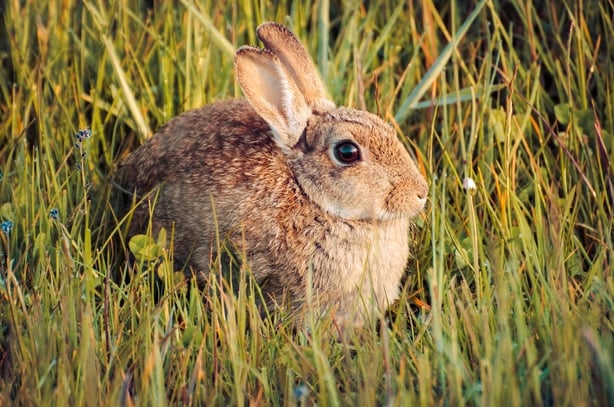
'As this is May', declared Alice,' the Mad March Hare won’t be raving mad, at least not as mad as it was in March’.
During the month of March, hares dash about the fields, sparring with each other like punch-drunk boxers. Actually, they start doing so in February and continue with their shenanigans in April. Contrary to popular belief, the combatants are not young bucks fighting for territories but females warding off the advances of males as the mating season gets under way. It’s more a case of sexual harassment than medieval jousting.
This lively animal arrived in Ireland at the end of the last ice age, long enough ago to have developed 'Irish solutions to Irish problems'. Over the millennia, it evolved into a sub-species not found anywhere else. Some even think that Lepus timidus hibernicus, the 'timid Irish leaper', is sufficiently different from its Scottish and European cousins to be given full species status; it’s slightly bigger and doesn’t turn white in winter. A tendency to go pale is still in the genes, however. Very occasionally, a completely white hare is seen. But the major difference is one of lifestyle. Mountain hares abroad are confined to high ground, our Irish one is found just about everywhere, right down to sea level.
There was a time when British hares also lived in the lowlands. Then another species, the brown hare, was introduced by the Romans. The blow-ins thrived in grassland, so much so that they ousted their native cousins and forced them to take to the mountains. Browns were released here also but, for some unknown reason, they did not prosper. There are some in Derry and Tyrone and possibly Louth and Meath. This suggests that the Irish hare, unlike its British counterpart, can out-compete brown ones in our lowlands. The evidence for this is conflicting, however. James Fairley found that there were far more hares on Mayo farmland than on adjoining heather moors but Karina Dingerkus, in a study in the North, reported the opposite; Irish hares were much less common on grassland there than on high ground.
Being an iconic animal is, however, no guarantee of prosperity and survival. The Irish hare, though much loved by the public, is not doing well. Following claims from landowners that numbers are falling, the National Parks and Wildlife Service began a two years study in 2006. Their report, The Status of Hares in Ireland, makes interesting reading.
The authors (there are eight of them) examined records of hares killed on large estates from the mid-1840s onwards. Many of the 'great houses' kept bag-total records of shoots. Up to 1914, when the First World War broke out, numbers remained stable but, from then on, there was a steady decline in kills. The two World Wars and the War of Independence complicated the picture but, using statistical pyrotechnics, these political and social upheavals were taken into account. The authors are confident that, while hares managed to hold their own in the 19th Century, their numbers fell steadily during the 20th. A similar analysis based on coursing club records was less conclusive.
Estimating the size of a hare population isn’t easy. These animals are active at night and spend most of the day hidden in long grass. They are impossible to count individually but sophisticated sampling techniques enable changes in the population to be detected over time. Detailed work was carried out by Queen's University on behalf of the Wildlife Service and 80 National Park staff members visited 691 2km squares of the National Grid. Counts were made at night, between January and March, when ground cover is lowest and hares are can be seen using spotlights shone from vehicles.
It’s estimated that there were 233,000 hares in the Republic in the spring of 2006 and 535,000 in 2007. Numbers fluctuate between years so no particular significance can be attached to this difference. About 50% were on farmland in 2006 and 70% in 2007. No brown hares were seen but there were 1,209 sightings of rabbits and 198 of foxes. Hares were distributed fairly evenly throughout the country, whereas rabbits and foxes were more abundant in the east and southwest.
Like all scientists, the authors are cautious about their findings. A long-term study will be required before we really understand the factors controlling our hare population.
Status of Hares in Ireland; Hare Survey of Ireland 2006/07 by Neil Reid, Karina Dingerkus, W. Ian Montgomery, Ferdia Marnell, Rebecca Jeffrey, Deirdre Lynn, Naomi Kingston and Robbie A. McDonald. Department of the Environment Heritage & Local Government.
